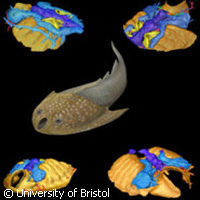Study shows link between ancestor's brain and evolution
Biologists recognised that the origin of a mouthful of jaws plays a critical role in our history of evolution but they were unable to use fossils to elucidate how. An international team of researchers suggests that the reorganisation of the brain and sense organs could shed light on the evolutionary success of vertebrates (animals with backbones). Presented in the journal Nature, the study takes a close look at the brain of a 400 million year old fossilised jawless fish, an evolutionary intermediate between the living jawless and jawed vertebrates. The research was partially funded under the EU's Seventh Framework Programme (FP7). Researchers from China, France, Switzerland and the United Kingdom investigated the structure of the head of a primitive fossil jawless fish called a galeaspid using high energy X-rays at the Swiss Light Source, Paul Scherrer Institut (PSI) in Switzerland. Their work exposed the shape of the animal's brain and sense organs. PSI's Professor Marco Stampanoni, a co-author of the study, says: 'We used a particle accelerator called synchrotron as X-ray source for performing non destructive 3D microscopy of the sample. It allowed us to make a perfect computer model of the fossil that we could cut up in any way that we wanted, but without damaging the fossil in any way. We would never have got permission to study the fossil otherwise!' 'We were able to see the paths of all the veins, nerves and arteries that plumbed the brain of these amazing fossils,' explains lead author Gai Zhi-kun of the University of Bristol in the United Kingdom and of Institute of Vertebrate Palaeontology and Palaeoanthropology (IVPP) in China. 'They had brains much like living sharks - but no jaws. We've been able to show that the brain of vertebrates was reorganised before the evolutionary origin of jaws.' Commenting of the results obtained in the study, Professor Philip Donoghue, one of the authors of the study, from the School of Earth Sciences at the University of Bristol, says: 'In the embryology of living vertebrates, jaws develop from stem cells that migrate forwards from the hindbrain, and down between the developing nostrils. This does not and cannot happen in living jawless vertebrates because they have a single nasal organ that simply gets in the way.' According to the researchers, their findings provided the answers they needed. 'This is the first real evidence for the steps that led to the evolutionary origin of jawed vertebrates,' says IVPP's Professor Min Zhu, and the fossil provides us with rock solid proof.' One of the challenges that scientists faced in their efforts to piece together this evolutionary puzzle was that the technology needed to carry out the work was not available. Says co-author Professor Philippe Janvier of the Museum national d'Histoire naturelle, Paris in France: 'This research has been held back for decades, waiting for a technology that will allow us to see inside the fossil without damaging it.' He points out that the scientists, despite their different fields of study, could not have conducted this research and obtained the necessary results if they had not collaborated on this together.For more information, please visit:University of Bristol:http://www.bris.ac.uk/Nature:http://www.nature.com/nature/index.html
Countries
Switzerland, China, France, United Kingdom



